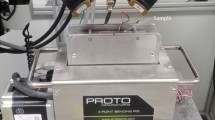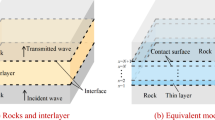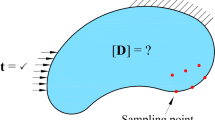Abstract
The paper presents a finite element study designed to gain physical insight into the effect of surface discontinuities on Rayleigh wave propagation in structural elements. In particular, a series of array measurements at various locations within a plate are simulated and compared with experimental measurements. Conversion of array measurements into the frequency-wavenumber domain reveals propagating Lamb modes, which are used to define Rayleigh wave motion. Numerical results show that Rayleigh waves measured after passing a fracture are composed of long wavelength Rayleigh wave energy propagating past the slot and short wavelength Rayleigh wave energy formed behind the slot.
Similar content being viewed by others
Reference
L. L. Morgan, “The spectroscopic determination of surface topography using acoustic surface waves”. Acustica 30, 222–228 (1974).
J. D. Achenbach, A. K. Gautesan and H. McMaken, “Application of elstodynamic ray theory to diffraction by cracks”, in Modern Problems in Elastic Wave Propagation, eds. J. Miklowitz and J. D. Achenbach International Union of Theoretical and Applied Mechanics, 219–237 (1977).
M. G. Silk, “The determination of crack penetration using ultrasonic surface surface waves”, Ultrasonics, 38, pp. 290–297 (1976).
M. Sansalone and M. J. Carino, “Detecting Delaminations in Concrete Slabs with and without Overlays Using Impact Echo Method”, J. Am. Concrete Instit. 86, pp. 175–184 (1989).
M. Hirao, K. Tojo and H. Fukuoka, “Spectrum Analysis for Rayleigh Waves Reflected from Small Fatigue Cracks”, Nondestruct. Test. Eval. 7, pp. 223–232 (1992).
I. Victorov, Rayleigh and Lamb Waves: Physical Theory and Applications 1967, Plenum Press, New York.
B. R. Tittmann, F. Cohen-Ténouodji, M. De Billy, A. Jungman and G. Quentin, “A Simple Approach to Estimate the Size of Small Surface Cracks with the Use of Acoustic Surface Waves”, Appl. Physics Lett. 33, pp. 6–8 (1978).
V. Domarkus, B. T. Khuri-Yakub and G. S. Kino, “Length and Depth Resonances of Surface Cracks and Their Use for Crack Size Estimation”, Appl. Physics Lett. 33, pp. 557–559 (1978).
B. R. Tittmann, O. Buck, G. Ahlberg, M. De Billy, F. Cohen-Ténouodji, A. Jungman and G. Quentm, “Surface Wave Scattering from Elliptical Cracks for Failure Prediction”, J. Appl. Physics 51, pp. 142–150 (1980).
C. H. Yew, K. G. Chen and D. L. Wang, “An Experimental Study of Interaction Between Surface Waves and Surface Breaking Crack”, J. Acoust. Soc. Am. 75, pp. 189–196 (1984).
M. Picornell and R. L. Lytton, “Field Measurement of Shrinkage Crack Depth in Expansive Soils”, Transport. Res. Rec. 1219, pp. 121–130 (1989).
M. E. Kalinski, K. H. Stokoe II, J. O. Jirsa and J. M. Roësset, “Nondestructive Identification of Internally Damaged Areas on a Concrete Beam Using the Spectral Analysis of Surface Wave Method”, Transport. Res. Rec. 1458, pp. 14–19 (1994).
A. Zerwer, “Near Surface Fracture Detection in Structural Elements: Investigation Using Rayleigh Waves”, Ph.D. Dissertation, University of Waterloo, Ontario, Canada, pp. 368.
A. Zerwer, M. A. Polak, J. C. Santamarina, “Experimental Investigation of Wave Propagation in Thin Plexiglas Plates: Implications for Modeling and Measuring Rayleigh Waves”, NDT&E Int. 33, pp. 33–41 (2000).
A. Zerwer, M. A. Polak, J. C. Santamarina, “Fracture Detection in Concrete Using Rayleigh Waves”, submitted to NDT&E Int. (2000).
A. Zerwer, M. A. Polak, J. C. Santamarina, “The Effects of Surface Cracks on Rayleigh Wave Propagation: An Experimental Study”, ASCE J. Struct. Eng. 128, pp. 240–248 (2001).
L. Rayleigh, “On Waves Propagated Along the Plane Surface of an Elastic Solid”, Proc. Lond. Math. Soc. 17, pp. 4–11 (1885).
H. Lamb, “On Waves in an Elastic Plate”, Proc. Lond. Math. Soc. 21, pp. 85–95 (1889).
J. Oliver, “Elastic Wave Dispersion in a Cylindrical Rod by Wide-Band Short-Duration Pulse Technique”, J. Acoust. Soc. Am. 29, pp. 189–194 (1957).
K. F. Graff, Wave Motion in Elastic Solids, 1975, Dover Publications, New York.
H. S. Valliappan and V. Murti, “Finite Element Constraints in the Analysis of Wave Propagation Problems”, UNICIV Rep. No. R-218, Oct. 1984, The University of New South Wales, The School of Civil Engineering.
M. Liu and D. G. Gorman, “Formulations of Rayleigh Damping and Its Extensions”, Comput. Struct. 57, pp. 277–285 (1995).
J. Koppelmann, “Uber die Bestimmung des dynamischen Elastizitätsmoduls und des dynamischen Schubmoduls im Frequenzbereich von 10–5 bis 10–1 Hz”, Rheol. Acta 1, pp. 20–28 (1958).
S. C. Hunter, “Energy Absorbed by Elastic Waves During Impact”, J. Mechan. Physics Solids 5, pp. 162–171 (1957).
T. M. Proctor Jr. and F. R. Breckenridge, “Source Force Waveforms: The Use of a Calibrated Transducer in Obtaining an Accurate Waveform of a Source”, J. Acoust. Emission 10, pp. 43–48 (1992).
J. A. Zukas, T. Nicholas, H. F. Swift, L. B. Greszczuk and D. R. Curran, Impact dynamics, 1982, John Wiley and Sons.
L. G. Peardon, “FK Techniques in Seismic Processing”, in Geophysical Signal Processing, eds. E. A. Robinson and T. S. Durrani, pp. 388–474, Prentice Hall, Englewood Cliffs, NJ.
D. N. Alleyne and P. Cawley, “A Two-Dimensional Fourier Transform Method for the Measurement of Multimode Signals”, J. Acoust. Soc. Am. 89, pp. 1159–1168 (1991).
D. N. Alleyne and P. Cawley, “The Interaction of Lamb Waves with Defects”, IEEE Trans. Ultrason. Ferroelectr. Frequency Control 39, pp. 381–397 (1992).
Author information
Authors and Affiliations
Corresponding author
Rights and permissions
About this article
Cite this article
Zerwer, A., Polak, M.A. & Santamarina, J.C. Rayleigh Wave Propagation for the Detection of Near Surface Discontinuities: Finite Element Modeling. Journal of Nondestructive Evaluation 22, 39–52 (2003). https://doi.org/10.1023/A:1026307909788
Issue Date:
DOI: https://doi.org/10.1023/A:1026307909788




